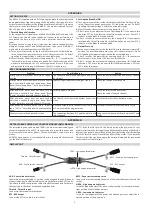
6
1. Turn your transmitter on.
2. Set the correct direction of servo throw for the throttle channel:
- Hitec, Multiplex, Graupner/HoTT and Pelikan radios: „NOR(MAL)“
- Futaba radios: „REV(ERSE)“.
3. Pull the throttle trim down at least to 24% (the required percentage may
vary with different radios - refer to Step 4 in the following chapter).
4. If you want to use both NORMAL and AUTO control modes, assign 2-posi-
tion switch to one AUX channel of your transmitter. Set the EPA of this
channel to at least 50% at both directions.
PREPARING THE RMS MODULE
1. Hook up the RMS module following the wiring diagram below. If the RMS
is to be operated in the AUTO mode only, leave the AUX input of the RMS
module unconnected.
2. As different transmitters have different throttle range, follow the ESC in-
structions in the „Appendix A“ to calibrate the throttle range of your ESC
- BEFORE you will start to set up and operate the RMS module.
3. Turn you transmitter on again, push the throttle stick all the way down to
the lowest position, flip the control mode switch to the „NORMAL“ posi-
tion.
4. Connect the power pack to ESC in your model.
The LED on the RMS module will light up and
the power unit unfolds upright.
Note:
If the throttle stick was not all the way
down or the throttle trim under 24% when you
connect the power pack to the ESC, the LED on
the RMS module would blink and the power
unit would not move, no matter the control mode.
5.
Test the retractable power unit operation in the NORMAL mode.
The
throttle stick controls just the RPMs of the motor; slowly pull the throttle
stick up, the motor should start to rotate. Pull the throttle stick all the way
down, the motor will stop again. Check the direction of rotation of the pro-
peller. If it was incorrect, simply swap any two of the three wires between
the ESC and motor.
Check if there is no buzzing of the power unit actuating servo in the un-
folded position. If necessary, adjust the high endpoint position of the
mechanism using the H-EPA adjuster on the RMS module.
CAUTION: Once the power pack is connected to the ESC, always handle
your model like the propeller might start to swing anytime! Keep well
off the prop!
6.
Test the retractable power unit operation in the AUTO mode.
Push
the throttle stick all the way down.
Flip the control mode switch to the
AUTO position. The power unit will
retract partially waiting in the “pro-
peller stop” position for 3 seconds -
you will see the black prop stopper
raise in the lover part of the power
unit pylon. The propeller has to be
perfectly upright in order to retract
the power unit to the fuselage cor-
rectly; the stopper is supposed to
stop the prop freely rotating by the
airstream. Doing the test on the
ground there is no airstream, so
you will have to - using a tool, NOT
YOUR FINGER! - push the prop to
engage the prop stopper located
in the lover part of the pylon. The
power unil will retract to the fuse-
lage then.
Check if there is no buzzing of the power unit actuating servo in the re-
tracted position. If necessary, adjust the low endpoint position of the
mechanism using the L-EPA adjuster on the RMS module.
The throttle stick is all the way
down (Positon “A”) - the power unit
has to be completely retracted into
the fuselage. Pull the throttle stick
up to the “B” position, the power
unit must unfold completely to the
upright position. Pull the throttle
stick further up, the motor starts
to rotate (up to position “C”, full
throttle).
Pull the throttle stick all the way
down, back to the position “A”, the motor will stop. The power unit will re-
tract partially waiting in the “propeller stop” position for 3 seconds. Again,
doing the test on the ground there is no air stream to rotate the prop, so
use a tool - NOT YOUR FINGER! - to push the prop to engage the prop stop-
per. The power unit will retract to the fuselage then.
Note: It is ABSOLUTELY ESSENTIAL to check there was no buzzing of the pow-
er unit actuating servo both in the retracted and unfolded position. Buzzing
servos draw excessive current that might overload the BEC stabilizer of your
ESC - in the worst case it might cause failure of the receiver and uncontrol-
lable crash of your model.
RMS
Throttle
AUX
Rx
Throttle
AUX
ESC
LiPo
RMS
ESC
RMS servo
RMS
Throttle
AUX
Rx
Plyn
AUX
Regulátor
LiPo
RMS
ESC
RMS servo
RMS
Throttle
AUX
Rx
Gas
AUX
Regler
LiPo
RMS
ESC
RMS servo
A
B
C
2-5°
DOWN
UP
DOWN
UP
A
B
C
2-5°
DOWN
UP
DOWN
UP
A
B
C
2-5°
DOWN
UP
DOWN
UP
A
B
C
2-5°
DOWN
UP
DOWN
UP
A
B
C
2-5°
DOWN
UP
DOWN
UP
PREPARING YOUR TRANSMITTER








